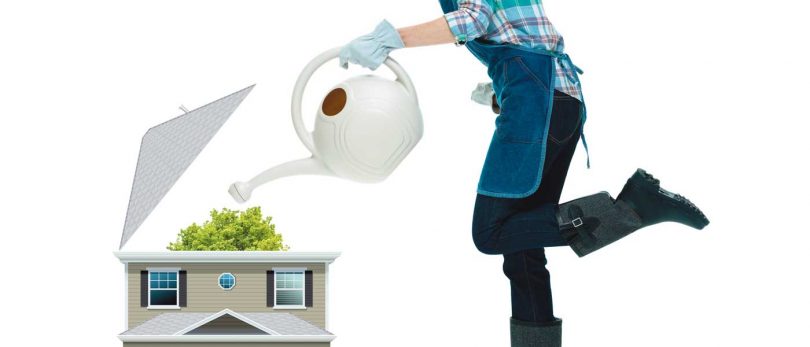Today’s homebuyers are less attracted to cosmetic aesthetics and more to a home’s bones, mechanicals and structural improvements
By Donna Shryer
Homebuyers—regardless of generation—want a move-in-ready home. That may sound like an old song, but looking forward there’s a new verse. Move-in-ready is less about trending pop and sizzle in the kitchen and bathroom and more about what’s going on behind, under and over those cupboards and fixtures.
According to a recent consumer survey by homebuilder Taylor Morrison, 62 percent of homebuyers most want energy efficiency and 56 percent seek easy maintenance.
Are homebuyers willing to pay for what they want? In most cases, yes, says Craig Webb, editor of Remodeling magazine and its annual Cost vs. Value Report. The 2018 Report, not yet released, cites at least a 10 percent drop in return on investment (ROI) for upscale remodeling projects. “The highest resale payback is in projects that involve replacing what’s broken, inefficient or outdated,” he says.
Here are several key areas where you can guide sellers through home décor and design trends, attract homebuyers and profitably close more sales.
Get FIXated
“Between Pinterest and HGTV, many sellers get caught up in visually preparing their home for sale,” says Lilli Schipper, CRS, REALTOR®, with Fort Lauderdale-based Island and Resort Realty. “Yet they forget about outdated mechanical and structural issues, which could come up during an inspection and end up killing the deal. Pre-listing inspections can sometimes provide more value than staging.”
Mechanical and structural improvements may not be the sexiest home trend, but it’s hot—and getting hotter. “In 2017, the payback for these kinds of projects averaged 74 percent. In 2018, it’s up to 76 percent,” Webb says.
Driving home this point, the 2017 Remodeling Impact Report, a joint study from the National Association of the Remodeling Industry (NARI) and the National Association of REALTORS® (NAR), gives a new roof a 109 percent ROI. The 2017 Cost vs. Value Report gives top honors to what’s going on under that roof, with a 107.7 percent payback for fiberglass attic insulation.
Debra Pitell-Hauge, CRS, broker-REALTOR® with Michael Saunders & Company, headquartered in Longboat Key, Florida, says it’s about fixing functional obsolescence. That can mean an energy efficient HVAC system, new windows and doors, or the ability to withstand almost anything that Mother Nature dishes out. “Here on Florida’s west coast, buyers want hurricane-impact glass. I’ve seen people buy their second-choice home because it’s hurricane proof.”
Curb your enthusiasm
“Curb appeal is more important than ever,” Pitell-Hauge says. “It’s partly because most people start their search online. So first they see the front of the house and then they move on to interior photographs.”
While every REALTOR® knows the importance of curb appeal, Webb emphasizes that exterior project ROIs have been outpacing interior projects for a while now—and are not expected to slow down any time soon. These exterior improvements include landscaping and fresh paint as well as new doors, windows, siding and roof.
Open floor plan 2.0
For years, many homebuyers wanted an open floor plan, with a seamless flow from kitchen to dining room to family room. Homebuyers still want an open floor plan—but now they also want flexibility. Or, as Taylor Morrison’s survey reports, 58 percent of today’s homebuyers want a floor plan that can be personalized.
Visually “explaining” an open floor plan’s flexibility ramps up the importance of professional staging, says Linda Rike, CRS, broker-REALTOR®, with Linda Rike Real Estate and serving Crystal Coast–Carteret County, North Carolina.
“A personalized floor plan implies creating living spaces where you want them to be. For example, in my market, the open formal dining room is making a comeback, so I might take an open space and stage a breakfast nook and a formal dining area—rather than one space for all meals.”
Or you may want to stage an open space with less family room and more home office space. Depending on your market, you might stage a smaller dining area and introduce room for a mixologist’s dream bar cart. It’s a visual solution for the increasing number of homebuyers who want to share the trending “cocktail experience” with friends.
Generally, stagers charge $300 to $600 for a consultation. Regardless of staging price, the payback can be substantial. According to the 2017 Profile of Home Staging report by the National Association of REALTORS®, 77 percent of buyers’ agents say staging a home makes it easier for a buyer to visualize the property as a future home and about one-third of buyer’s agents feel that staging increases the dollar value offered from 1 to 5 percent when compared to similar unstaged homes on the market.
A warm welcome
Houzz predicts that 2018 home design and décor will go to bold, warm colors—like ruby red, grays with a hint of brown, and rich, earthy shades of camel, rust, tobacco and burnt yellow. Vibrant floral patterns are expected to bloom from ceiling to floor. Not a warm color fan? Sherwin-Williams named Oceanside SW 6496 as its 2018 Color of the Year, describing the cool, deep tone as a rich blue that collides with jewel-toned green.
These colors are fabulous, but potential ROI disasters if permanently applied to walls, floors, fixtures or cabinets while preparing a house for sale, says Kathy Novak, CRS, REALTOR®, with Howard Hanna Real Estate serving Northeast Ohio. “Use color trends for furniture, bathroom towels and shower curtains, and kitchen knick-knacks, but not for anything that’s permanent.”
Specifically addressing walls, anything bolder than warm gray, warm beige, or better yet, a combo called warm greige, can immediately shut a buyer down, Rike adds. “The first thing that pops in their mind is: ‘I’ll have to spend a fortune to repaint the whole house.’ With that, they move on to the next property.”
Counter intelligence
Yesteryear’s stark, all-white kitchens are warming up with vibrant pops of color, dark wood floors, dramatic statement tile work, black appliances and countertops created from a myriad of materials. However, Schipper says, these are pricey, upscale trends meant for personal enjoyment—but not investment. “If you put $80,000 into a new kitchen, do it for yourself and enjoy! Just don’t expect to get it back on resale value.”
The 2017 Cost vs. Value Report and the 2017 Remodeling Impact Report agree, both giving a major, upscale kitchen remodel a slim ROI of only 62 percent.
The general consensus is to keep kitchen updates down to a new granite countertop and perhaps a new sink. As Pitell-Hauge explains, “In high-priced markets, I believe buyers will tear the kitchen out and put in what they want, regardless of what you’ve done. In mid-priced markets, buyers won’t likely be able to afford the additional cost to cover a major kitchen remodel.”
Floor it
Hardwood flooring continues to attract homebuyers. Popular alternatives range from distressed or reclaimed wood for a rustic look to sophisticated dark hardwoods stained sleek black to traditional oak, which remains a perennial fan favorite. However, with more trends than ever, it’s tough to know which look will grab a homebuyer’s second glance.
For that reason, it’s often better to professionally clean existing carpet or refinish existing hardwood floors. The 2017 Remodeling Impact Report gives refinishing a solid thumbs up, citing a 100 percent ROI.
The projects attracting homebuyers aren’t necessarily inexpensive, but they typically cost less than a luxury kitchen remodel or bathroom addition, Webb says. That means sellers need to invest less to prepare a home for sale and will likely recoup more—if not all—of their investment. As for sellers who think they need to present an upscale trend-worthy home, well, that only happens on HGTV. 
The myth of the fixer-upper
Every REALTOR® has sellers who insist they’d rather price their house to sell as is. In theory, it’s an approach that should work—but it doesn’t, says Leigh York, CRS, REALTOR® in Fort Worth, Texas, with CENTURY 21 Judge Fite Company.
“Whatever the cost to update, repair or fix, the homebuyer typically doubles that price when it’s time to negotiate. Now combine that with the fact that buyers often think in increments of $1,000. So if it costs $800 to have those floors cleaned, the buyer says it will cost $2,000, and that’s what they deduct from their bid. Giving buyers an option to update themselves can cost sellers a lot of money.”
Explain things in terms of dollars and you have an argument that persuades almost every seller to properly prepare their home for sale, York adds.








